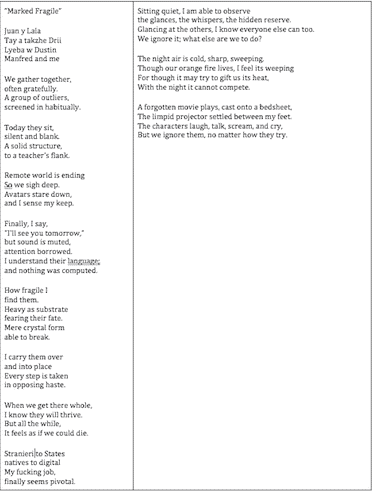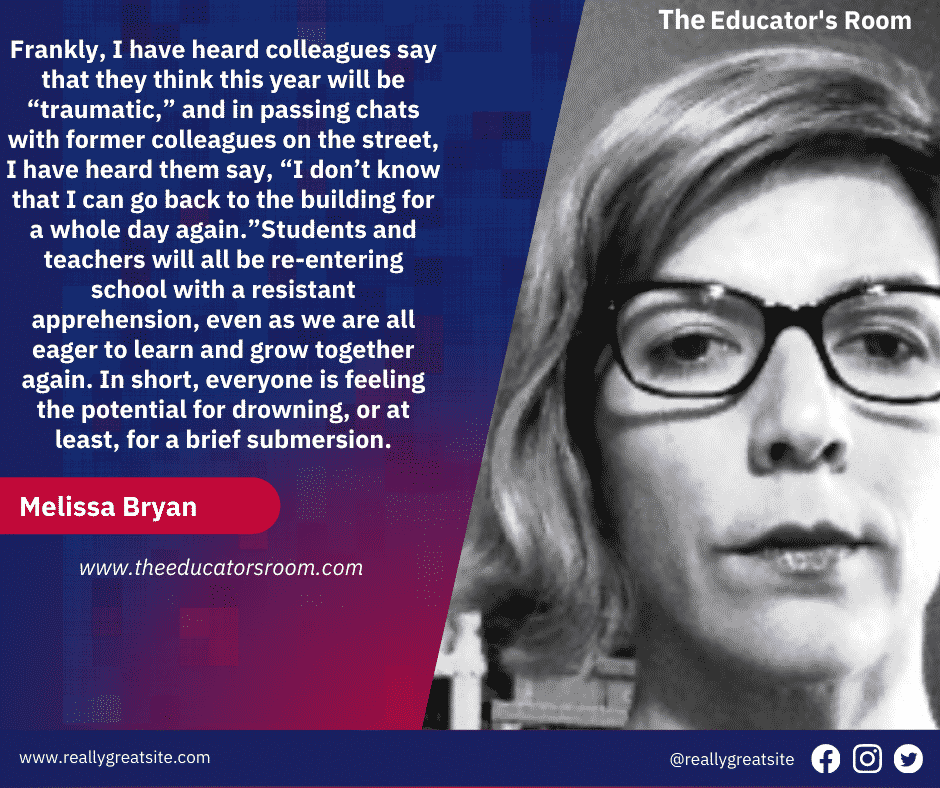by Melissa Bryan
Transitioning Into September
Last week, in an online educational leadership course I attended, we viewed a scene from the film Invictus. In it, Nelson Mandela (played by Morgan Freeman) explains to pro-Rugby player Pienaar (played by Matt Damon), what helped him survive imprisonment. Nelson relates that a poem, “Invictus” by William Ernest Henley, gave him the inspiration to endure. The poem motivated him to be more than he expected he could be. In his case, a survivor.
In reading through and responding to peer comments on Mandela’s inspirational confession, a few people replied that it didn’t occur to them that literature or reading others’ words could be a source of inspiration, or, for that matter, an affirmation of leadership. To them, Pienaar’s more relatable response to Mandela, namely that a song is what he and his teammates use to prepare for a big game, was the more intuitive and natural initiating motivator.
Either way really, in Mandela’s poem or Pienaar’s song, the impetus is still the same. The singing quality of poetry has a resonant and necessarily ordering quality for all of us.
Gregory Orr states in A Primer for Poetry and Readers of Poetry that:
Disorder outside us (past and future); disorder inside us (shifting moods and anxious
fantasies, the scattered chatter of the voice). In the ordinary, mildly chaotic world of
daily life, we somehow manage to balance between disorder and order. We usually keep
ourselves steady enough moving between disorder and order. But when something destabilizes us, it might well qualify as a crisis of self. And it is precisely to help us respond to such crises – be they positive or negative, minor or major – that culture invented lyric poetry. (Orr 21)
Orr 21
To Orr, “lyric poetry” works to “carve away excess” and it “seeks a center that is emotionally charged” through the ways it attends to spaces, pauses, meter, various forms of rhyme, syllable counts, the economy of lines, lineation, and compression of content. It is an intensity of emotion distilled and presented rhythmically (Orr 84). To Orr’s mind, it was created by culture specifically to help us manage the internal or external disorder that destabilizes us and causes a self crisis. While few of us can claim to be poets, there is an intuitive desire to and inclination toward the production of poetry (as a friend said to me years ago: “poetry is a sixth sense”). The point being raised by Orr is that, for many of us – for example, in our youth when crafting a love poem (or writing a love song) – poetry is spontaneous. Why? Often, the object of our poem is so new and the feeling so unmooring that it needs to be processed externally and compactly to help us return to a sort of psychological or emotional homeostasis.
In other words, lyrical poetry just sort of materializes impulsively from each of us. Thankfully, too, when we put those words onto the page, arrange and order them, and let them sing, we leave feeling our inner world has been reordered. Like when Mandela read “Invictus,” he (and we whether we are reading or writing poetry) feel inspired. Indeed, we feel motivated and in control of our present and hopeful for our destiny.
As the mid-summer weeks lengthen and stretch us into more malleable forms of ourselves, we tend to have time to think peripherally about the coming school year. This year, the flooded pool of summer classes and my summer reading is never far from my thoughts as I try to predict what the new year will bring us. Story-syntax has always afforded me some predictive powers, but since this year is another “first” year, I’ve been searching for some intuitional guidance. What we do know is that re-entry will occur on a much grander scale, and a “successful September” seems fraught with a shaded vaguery. Disorder looms and hangs bleakley over the future.
As a high school teacher, we will be addressing the in-take of over a thousand students (some with masks and some without), another year with new protocols and distance requirements; for those of us who taught hybrid or remote or a version of that instruction, we will be returning to traditional instruction in large measure, and many of us may even still be teaching, in some form, through Google Meets or Zoom. Presumably, too, we will be re-entering to longer school days, a return to the faster-paced curriculum goals, SGOs and quantified assessments of our abilities, proctoring, tracking, and grading national, state, and building-level high stakes tests again, and we will return to our hefty meeting and duty schedules. The diverted attention of the presentist’s world is back, and yet – even as adults – we might not be truly ready for it.
Of course, our students will be returning, too, to a sobering wave of pre-pandemic reality. They may be arriving having received a vaccination or not, some have been home for a year and a half and it will be their first return to school in a long while, and in a sea of disorder and anxiety – not just disease-induced anxiety either, but general school avoidance anxiety – students will be asked to swim the same laps and with the same stamina as they did before the pool was drained on us all in March 2020.
Frankly, I have heard colleagues say that they think this year will be “traumatic,” and in passing chats with former colleagues on the street, I have heard them say, “I don’t know that I can go back to the building for a whole day again.” Students and teachers will all be re-entering school with a resistant apprehension, even as we are all eager to learn and grow together again. In short, everyone is feeling the potential for drowning, or at least, for a brief submersion.
Last year, for example, students across the US were surveyed about their well-being with over 50% indicating that they were uncertain about their future. Other alarming and relevant statistics included that nearly 30% felt constantly under strain, while over 30% reported feeling unhappy and depressed. The norms of the last year and a half have altered the way we live, how we feel, and our ability to and belief in our own unmitigated, interminable endurance.
What’s more is that there is little direction from the district, state, and national governance as to how we will proceed. Even proactive research and publication on the realities of re-entering schools in the fall seem shockingly scarce. The public discourse as a flotation device hasn’t been adequately offered, and so it seems teachers and students will have to find a way to wade into the water together.
It is for this reason, I think, we take Orr’s advice or Mandela’s sage council. When we consider the ways we should, as teachers of the Humanities, re-enter in September, one way we can help order the destabilization we sense and lessen the pervasive anxiety we feel is to have our students write poetry.
Adolescent psychologists have been writing about the need for flexibility when it comes to re-entry now for months, and what better way than to start the year with an agency-inducing creatively necessary poem? We ELA educators gain a lot from having our students write poetry from the outset.
- It reveals a great deal about how they are feeling (at present or throughout these last two years).
- It helps them practice precision in writing, and opens them up to the artistry of language through their focus on sound, images, and form.
- Teachers will develop those deeper (connected learning) connections that help us really know our students, and then ultimately, teach them better throughout the year.
- It is a form of SEL education and is culturally responsive, too.
Not to mention, if ever it seemed like the time to scratch the offputting syllabus introduction, the class rule-setting charade, or the stifling summer reading assessments, and “go for broke” with a little atypical poetry writing experience, it is now.
Poetry As Machine
In practical terms, the way we might engage students in this early writing task is not all that challenging, even for those educators or students who tend to flee poetry like they hear the theme music from Jaws whilst in the water.
While poetry has that daunting and untouchable quality for many of us, it really is a little “machine.” Zapruder writes in Why Poetry, “The poem makes poetry happen in the mind of the reader or listener. It happens first to the poet, and in the course of writing, the poet eventually makes something, a little machine, one that for the reader produces discoveries, connections, glimmers of expression” (11). In this way, poetry composition isn’t proprietorial and onerous. It isn’t meant to be threatening. Meaning is made by the reader, and the poet can construct it as if rebuilding a simple engine. Perhaps that’s all a little reductionist, but the truth is that poetry is a naturally expressive art that has forms and styles ready-made for imitations. In fact, Zapruper writes, “The more poetry I read, and wrote, the more clearly I saw that there really is no such thing as “poetic language.” The words in poems are for the most part the same as those we find everywhere else. The energy of poetry comes from the reanimation and reactivation of language that we recognize and know” (9). In other words, poetry isn’t difficult to compose nor is it intentionally undecipherable for the reader; poetry is organized, mechanistic, and literal.
There are several ways to accomplish the active writing of poetry. One way I approached this activity last spring was through deconstructing Mark Doty’s Analysis of Display of the Mackrel. Using his essay, “Souls on Ice,” I bulleted the essentials of his poetry creation method for my class:
- “I almost always begin with description, as a way of focusing on that compelling image, the poem’s ‘given.’”
- “If I do my work of study and examination, and if I am lucky, the image which I’ve been intrigued by will become a metaphor, will yield depth and meaning, will lead me to insight.”
- “There’s something else, some gravity or charge to this image that makes me need to investigate it.”
- “There’s a terrific kind of exhilaration for me at this point in the unfolding of a poem, when a line of questioning has been launched, and the work has moved from evocation to meditation.”
- “The drama of the poem is its action of thinking through a question.”
-First, it is best to tell them straight away that they need to compare an image to something abstract. Then, have students write a series of “I remember” statements like I was counseled to do in a recent poetry course I took. The “I remember” statements help them conjure up the events of the last year in image and precision, and those events become the basis of the abstraction. From there, students will develop the description of the most evocative memory.
- I remember headsets and mics, and wires, and plastic confining me and tethering me to machines.
- I remember walking backwards against the one-way arrows and hoping security wouldn’t catch me.
- I remember black boxes, blank faces, foreheads, ceilings, and red mics. How many times did I ask, “are you with me?”
Next, like Doty, that descriptive image of memory will become a metaphor. Once the object and abstraction are compared in the poet’s mind, Doty rightly moves toward infusing the metaphor with gravity and meditating on it. This is predominantly, I think, the work of poetry. The meditation and expansion of the comparison develops something ordering and “fresh” (to quote Orr) that sings to and inspires us all. There are a few ways to counsel students through the expansion of the metaphor, but two simple ways are:
1) tell them to list all of the words related to the metaphor itself. That generative list becomes the keywords that they will use to extract the most meaning from their metaphor throughout the poem.
2) write beside them. In doing so, you model processes and they think aloud with you. It is through the process where confidence is built. So praise the process!
It doesn’t matter if students write a sonnet, villanelle, ode, or a singing free verse poem, but they should aim for about fourteen lines at least. Then, too, suggest that they consider the number of syllables on each line since rhythm can be realized through syllabic equity and lineation starts to become purposeful that way as well. In the end, every poem has a “turn,” a “volta” or an “epode” that seeks to resolve the dramatic tension (action) of the poem. As Doty writes, once he understands “the poem’s subject-beneath-the-subject, the final stanzas of the poem [open] swiftly.”
Finally, direct them to write a title that is an addition to their poem. Poem titles, like all titles, orient the reader in time and space, and I always suggest titling a work at the end because it offers that extra special quality of closure for the writer, too. That elusive feeling in life – a known and understood ending – can be satisfyingly experienced in a well-chosen title.
This is not an activity that needs to take many days, but it is one that works essential skills while allowing some immediate flexibility and healing to occur during those first days back.
Be sure to communicate to classes that art isn’t for art’s sake. It isn’t about being perfect in this context or space, it isn’t about accolades or the hand print marked on a wall for all eternity to recollect one’s existence, and it isn’t about publishing or sharing far and wide digitally; art can, and the poetic form, in particular, does communicate and correct our own inner crises. It is in that spirit that I offer two poems as examples. One I wrote alongside my students in June, the other – a far more eloquent effort – was written by one of my students during that same class period. Together we followed some of the protocols, forms, and analysis mentioned here as we wrote about our own disorder.
In “Marked Fragile,” I wrote about my ESL class and how nervous I felt when, in April, schools were opening up again and a class – one separated by cultures, ages, grades, language, and digital spaces – was being asked to return to school. A place foreign and inhospitable to them even before Covid, the school became ever more inhospitable after the long remote months. Poetry ordered for me what I couldn’t accept in reality – bringing kids back without proper institutional support in place.
It is evident in the samples provided that we aimed for expanded metaphors, conscious sound efforts, and purposeful lineation, as well as endings that moved our thinking to new and more accepting places. Enjoy!

Additional Reading & Special Thanks
Time Magazine: Education Edition
Special thanks to Kathleen Graber, Professor at FDU in the Creative Writing MA program.





